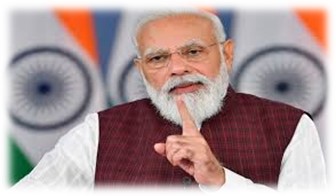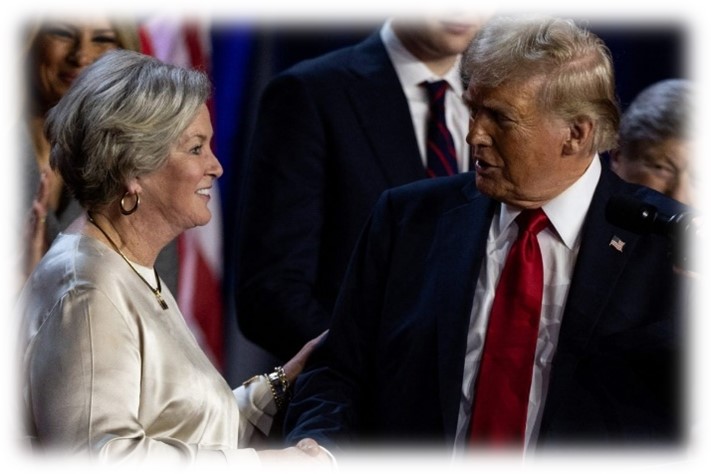Bengalis’ one of the big festivals after Durga puja is Jagaddhatri puja. It begins in 10th November, Sunday.
In West Bengal, the sacred festival of Jagaddhatri Puja is celebrated in honour of the goddess Jagaddhatri, who is an incarnation of Maa Durga. The date of the 2024 Jagaddhatri Puja was set for Sunday, November 10. The holiday was particularly advantageous for devotees because it fell on the same day as Akshaya Navami.
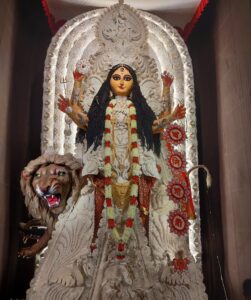
Schedule of Jagaddhatri Puja,2024
| Date and Time | Tithi |
| 11:15 PM on 8th November, Friday | Ashtami Tithi |
| 10:45 PM on Nov 09, Saturday | Navami Tithi Begins |
| 09:01 PM on Nov 10, Sunday | Navami Tithi Ends |
| November 10, Sunday | Akshaya Navami |
Significance of Jagaddhatri Puja
The name ‘Jagaddhatri’ is derived from the Sanskrit words “Jagat” (universe) and “Dhatri” (holder or nurturer), representing the goddess as the guardian and sustainer of the cosmos. Jagaddhatri Puja is an important religious festivity honouring Goddess Jagaddhatri, regarded as the ‘Mother of the World’ or the ‘Sustainer of the World.’
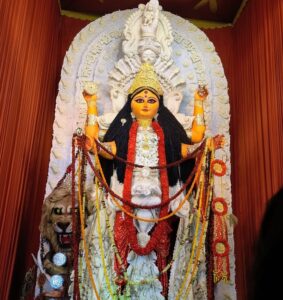
This puja is a crucial component of the Bengali religious calendar and is particularly significant in regions such as Hooghly, Kolkata, and other areas of West Bengal. Goddess Jagaddhatri is depicted as a serene and compassionate deity, holding a conch, discus, trident, and a lotus, symbolising peace and the triumph of good over evil. Unlike the fiercer forms of Goddess Durga, Jagaddhatri is often shown as calm, symbolising her role as a nurturing and protective mother.
The puja acts as a reminder of the importance of nurturing, care, and protection in our lives. As the ‘Mother of the World,’ Jagaddhatri represents the traits of kindness, sympathy, and affection. Worshippers hold the belief that when they conduct this puja with sincerity, they attain the goddess’s blessings for wealth, joy, and safeguarding from all earthly challenges.
Besides its spiritual importance, Jagaddhatri Puja also represents a period of communal harmony and cultural representation. Temples and pandals (temporary structures for celebrations) are decorated with intricate designs, and the celebrations feature cultural performances, music, and traditional dancing.
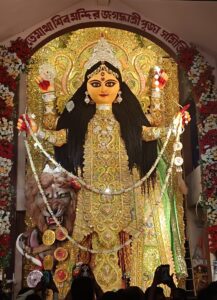
Rituals Related to Jagaddhatri Puja
- Bodhon (Waking the Goddess): The puja begins with the invocation of the goddess, welcoming her into the home or temple.
- Offering of Prayers: Devotees offer flowers, fruits, sweets, and incense to the goddess.
- Sankalpa (Commitment): Devotees often make a vow or Sankalpa to the goddess, promising to uphold good deeds and live in harmony.
- Arati: An evening ritual of singing hymns and performing rituals with lighted lamps.
- Community Celebrations: The puja is followed by processions, cultural events, and community meals, symbolising unity and togetherness.
Mythical origin of Goddess Jagadhatri
According to legend, following Mahisasura’s defeat, all the devatas grew arrogant. They believed that Goddess Durga could only conquer the demon due to the weapons provided to Her by the devatas. They could not comprehend the significance of the primordial force in the triumph. Brahma, aiming to help the devas recognize their error, manifested before them as a Yaksha. He summoned the deities to shift a shard of glass. Vayu, the deity of wind, asserted that He could dislodge massive mountains and trees and would definitely be capable of shifting a small piece of glass. Yet, in spite of all His efforts, he was unsuccessful.
A similar destiny confronted Agni, the fire god, whose ability to consume nearly anything was powerless against the tiny blade of grass. Gradually, every other god did the same. Before long, they recognized that their strength by itself meant little. Their strength came from the authority of the Supreme Mother, Maa Jagadhatri, who encompasses all of creation.
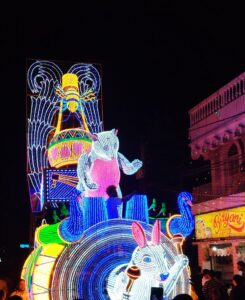
As this final understanding struck them, their ego transformed into an elephant. Mother Adi Shakti manifested before them as Jagadhatri.
The True Essence of Maa Jagadhatri
Sri Ramakrishna stated, “Jagaddhatri emerges within the heart of an individual who can tame the wild elephant known as the mind.” It is thought that anyone who reverently worships Maa Jagadhatri loses their sense of pride. He subsequently becomes a servant of Brahman, which reveals itself throughout the entire Brahmanda or the Creation.
In Chapter 5, Verse 13 of the Bhagavad Gita, Sri Krishna states,
sarva-karmāṇi manasā sannyasya te sukhaṁ vaśī
nava-dvāre pure dehī na kartum na kārayet
This implies, “The self-disciplined and detached embodied beings dwell joyfully in the nine-gated city, free from the belief that they are the creators or responsible for anything.”
An individual can achieve self-control and detachment only by mastering his mind or ego, the ‘elephant’ upon which Maa Jagadhatri gracefully resides.
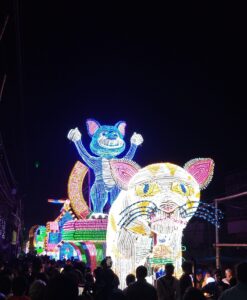
Past Celebrations and Initiation of the Festivals
Jagadhatri Puja is observed with great grandeur and celebration in Chandannagar, Kolkata and many other regions in West Bengal.
When all the Bengal was under the rule of British, Chandannagar established a unique tradition despite being under French administration at that time. Jagadhatri Puja is an important cultural and social celebration in this area.
The early history of Jagadhatri Puja in Chandannagar remains a mystery even now. Indranarayan Chowdhury is said to have brought the Jagadhatri Puja to Chandannagar in the style of King Krishnachandra from Krishnanagore. Indranarayan Choudhury passed away in 1756. Indranarayan Choudhury did not at all introduce the Jagadhatri puja in Chandannagar. Indranarayan Choudhury conducted the Jagadhatri puja in his residence in Chandannagar when Krishna Chandra would visit to borrow money from him. It is possible that Krishnachandra was drawn to the magnificence of Jagadhatri during this period.

The celebration was initiated by Maharaja Krishna Chandra in Krishnanagar in 1754. Legend has it that the goddess visited the Maharaja in his dream as a young girl, requesting him to worship Her in the form She opted to present to him. Then She became a goddess, illuminating the world with radiance, perched on a lion and gripping a conch, chakra, and bow and arrow in Her hands. ISKCON Vrindavan commemorates Jagadhatri puja in the sacred Braj.
Present Celebrations
For the first time, the Central Puja Committee in Chandannagar opted to conduct Facebook live streaming of the Jagaddhatri Puja procession, enabling individuals worldwide to observe the magnificent procession of Jagaddhatri idols from different Puja committees without needing to be there in person. The procession of idols took place starting the evening of November 11 and went on until the early hours of November 12. The Jagaddhatri Puja was observed on Friday (November 8).
The Jagaddhatri Puja is observed in Chandannagar over a span of four days. Numerous individuals from around the state gathered in different Puja pandals to catch a sight of the idols and the stunning lighting. A primary appeal of Jagaddhatri Puja in Chandannagar was the parade of idols that resembled a carnival.
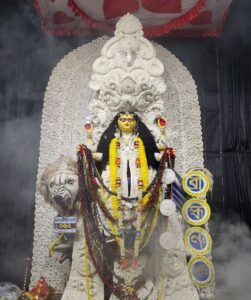
Idols are brought to the riverbanks for immersion during the procession. Individuals form a queue on either side of the street to observe the occasion. Chandannagar in Hooghly is renowned for its festival celebrations featuring intricate light displays on the streets and magnificent pandals for the goddess, who represents another form of the Hindu goddess Parvati. Chandannagar ranks first in light decorations for a festival. The entire city transforms into a “city of lights” as all the streetlights are extinguished to allow the decorations and pandals to illuminate.
